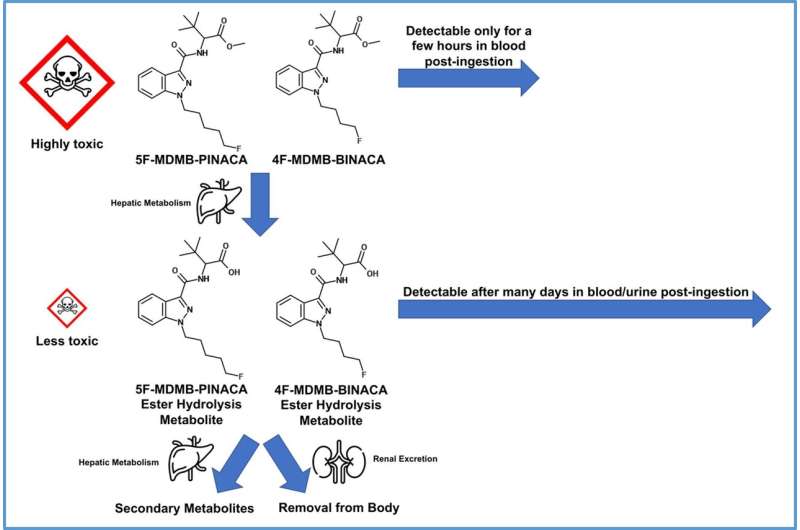Diagnosing intake of two new psychoactive substances

NUS pharmaceutical scientists have developed a systematic approach to understand how the human body manages two new psychoactive substances (NPS) by predicting their biological half-lives and measuring their biological activities against cannabinoid receptors. These NPS are synthetic cannabinoids (SCs) abbreviated as 5F-MDMB-PINACA and 4F-MDMB-BINACA. Their findings will help develop guidelines to detect the ingestion of SCs among abusers and better manage their toxicity manifestations.
SCs are novel drugs that elicit similar psychoactive effects as cannabis and may be subject to potential abuse. Understanding their biological effects and toxicological profiles can facilitate forensic authorities in developing more effective diagnostic biomarkers and clinicians in understanding the toxicities of SCs among abusers. These SCs are broken down completely by the liver after consumption to metabolites in a matter of hours and they become virtually undetectable in blood and urine samples. The development of reliable biomarkers is important to identify if a test subject had consumed these compounds. Additionally, the relative biological activities and adverse effects due to the parent compounds and their major metabolites are also not clear.
The research team from the Department of Pharmacy, NUS, comprising Prof Eric CHAN and his PhD student Eleanor CHEONG and Final Year Project student LIE Wen had investigated the biological half-lives and cannabinoid potencies of the two SCs and their major metabolites (see Figure). In collaboration with analysts from the Health Sciences Authority of Singapore, the team first performed a series of in vitro experiments and established the primary enzymes in the body that break down these two synthetic cannabinoids. These two enzymes are known as carboxylesterase 1b (CES1b) and cytochrome P450 3A4 (CYP3A4).
The team also found that the metabolites from these two SCs have markedly reduced cannabinoid potencies and possibly lower toxicities when compared to their parent compounds. Taken together, this means that inhibiting the metabolizing enzymes CES1b and CYP3A4 is likely to augment the adverse effects of the parent SCs. Certain antifungal medications and anti-HIV medications are typical inhibitors of CYP3A4. Clinicians should ensure that these medications are not concurrently administered to a patient experiencing 5F-MDMB-PINACA or 4F-MDMB-BINACA toxicity.
Based on laboratory experiments, modeling and simulation, the team predicted that the metabolites of 5F-MDMB-PINACA or 4F-MDMB-BINACA have a half-life of 17.5 and nine hours respectively. This means that the metabolites remain in the body longer than their parent compounds after consumption and they are detectable from biological samples for approximately four and two days, making them suitable candidates for potential urinary biomarkers.
Prof Chan said, "In the absence of clinical data, our mechanistic quantitative simulation approach is valuable as it provides preliminary biomarkers and detection windows for forensic authorities to further investigate the ingestion of different classes of NPS."
More information: Wen Lie et al. Diagnosing intake and rationalizing toxicities associated with 5F-MDMB-PINACA and 4F-MDMB-BINACA abuse, Archives of Toxicology (2020). DOI: 10.1007/s00204-020-02948-3





















